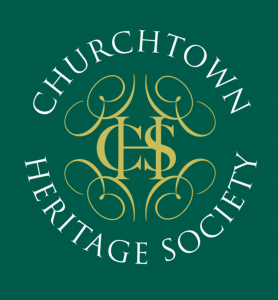Sir Richard Cox, Baronet, Lord Chancellor of Ireland, writing in the year 1688 describes Churchtown village as follows:
Churchtown, a small market town, near which is a large noble park and in it is a stately mansion named Burton Hall, belonging to Sir Richard Percival.
 Churchtown village is prettily situated in a fertile corner of north County Cork. The village, which formerly contained a number of thatched houses, was attacked and the greater part of it, including the Police Barracks burned in the year 1822. It was rebuilt between the years 1825 and 1849.
Churchtown village is prettily situated in a fertile corner of north County Cork. The village, which formerly contained a number of thatched houses, was attacked and the greater part of it, including the Police Barracks burned in the year 1822. It was rebuilt between the years 1825 and 1849.
In the years following the attack and the burning, Sir Edward Tierney, agent to the Earl of Egmont, the landlord, cleared away all the thatched houses and rebuilt the village in the form it is in today. Samuel Lewis reporting on the state of the village in the year 1837 says the village contains several neat slated houses, a good inn and a constabulary police station.
The new Catholic Church was built in 1839. A fine Market House was built in 1845 and the school was built in 1846. In the year 1849 the village of Churchtown was completed. To this day it remains largely intact.
Churchtown creamery was built in the year 1889. It was owned and worked by a number of farmers known as the Churchtown Creamery Co. In those far off days the amount of milk taken in daily amounted to 3,000 gallons.
The village was built in the form of a square. One side of it was named Egmont Row, the main street of the village was named George’s Street and that running west was named Kerry Lane. The double row of houses on the Buttevant road was named Chapel Lane and the road leading in the direction of main Cork/Limerick road to the east was named Lodge Road.
At the northern end of George’s Street are the entrance gates and lodge to Churchtown House. About three hundred yards to the west of the village at a place called Maryfield, stood the Church of Ireland, Parish Church. This is now part of the GAA grounds.
Churchtown village has a long and proud history and the parish will celebrate the 150th anniversary of its rebuilding in 1999.
Based on an article by the late Jim McCarthy that appeared in The Avondhu, 15th August 1991.
Additional material …
Churchtown parish has been occupied since Neolithic times as evidenced by the discovery of bronze age implements in the locality. The village itself was originally a collection of hovels until the early 1800s when the Earl of Egmont developed what is now a lime stone- built village. The village was well established by 1845 when the Famine struck the land. Many people were employed in Famine relief work in the parish but still many perished or emigrated to the United States and Britain during those years.
In the 1600’s the parish population exceeded 3,000. In the early 1900’s the village thrived with a wide range of local services such as public houses, creamery, bakery, butcher, tailor, forge and shoemaker.
While the parish population has declined considerably over the years and a number of houses are unoccupied, the village remains largely intact and has the potential to become a really vibrant place. Former generations have left a great legacy of wonderful stone buildings in the village. The ‘old’ school building which was built in 1846 and the 1845 stone-built Market House are fine examples of Churchtown’s heritage.
In recent years Churchtown has begun to see a commercial renaissance as new nursing home opened and development of major tourist initiative begins. Much remains to be done for the Churchtown Village Renewal Trust to achieve its objectives.




